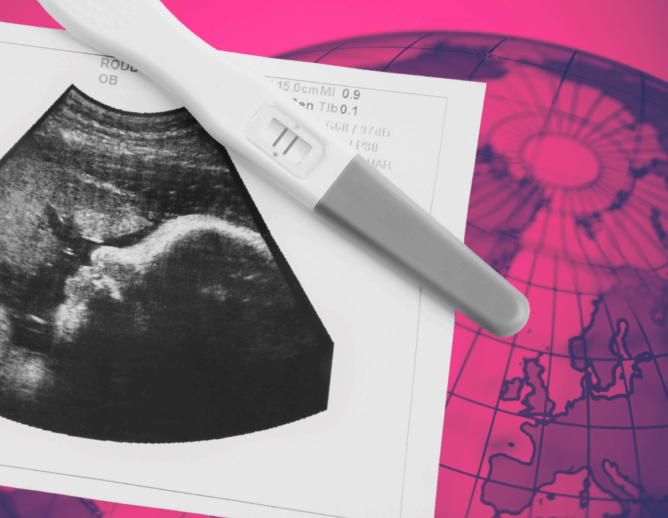Since taking office earlier this year, the Trump administration has solicited suggestions for and proposed various programs and policies aimed at encouraging childbirth and increasing the birth rate in the United States. The policy ideas discussed in April 2025 included everything from menstrual cycle tracking classes to track fertility, medals of honor for women who have multiple children, baby bonuses, and more. More recently, The New York Times reported that the Trump administration intends to use Title X funding — traditionally used to provide affordable family planning and preventative health services to low-income women — to establish an “infertility training center.” These centers would focus on educating people about the root causes of infertility, holistic infertility treatments, and more.
This development marks the latest report amid the increasing news coverage of policy proposals aimed at increasing birth rates across the United States. Notably, these policies fail to recognize or address high maternal mortality rates, the decimation of access to reproductive health care, and socioeconomic factors that impact birth rates. Policies that prioritize increasing birth rates without addressing other structural health inequities risk worsening reproductive and sexual health outcomes.
What is Pronatalism, And Why Is It on the Rise?
There is no precise definition of “pronatalism” due to the wide range of beliefs within the movement. However, pronatalists generally support policies that aim to increase birth rates by encouraging people to have more children. This ideology includes the belief that having more children is good for society and that people should be having more children to address declining birth rates and, therefore, a shrinking workforce; further, pronatalists believe that the government should actively incentivize people to give birth. At its core, pronatalist policies are often rooted in racist, sexist, and ableist notions about the role of women and children in our society.
Support from the current presidential administration has led to the recent surge in media coverage about pronatalist policies. President Donald Trump, Vice President JD Vance, and Elon Musk have all expressed their desire for people to have more babies in the United States. Additionally, Trump’s Secretary of the U.S. Department of Transportation (DOT) released a memo stating that “DOT-supported or assisted state contracts shall prioritize projects and goals … that give preference to communities with marriage and birth rates higher than the national average.”
How Do Pronatalist Policies Harm Health Outcomes?
Pronatalist policies that ignore various structural inequities impacting health have the potential to harm a range of reproductive, maternal, and general health outcomes.
Sexual and Reproductive Health Care
Support for pronatalist policies often coincides with efforts to restrict access to sexual and reproductive health care services, such as abortion, contraception, and gender-affirming care. For example, in a recent federal court case, the challengers raised problematic pronatalist arguments when challenging the FDA’s approval of mifepristone, stating that the FDA’s approval of the drug injured them due to the decreased number of births and, therefore, loss in population as a result of increased access to abortion. Similarly, pronatalists often tout dangerous rhetoric that increases in sterilization rates, which prevent procreation, as a reason to restrict access to gender-affirming surgery.
Maternal Health
Childbirth is deadlier in the United States than in any other high-income country, especially for Black and brown people. Further, 80% of maternal deaths in the United States are preventable. A recent study found that, from 2018 to 2022, pregnancy-related deaths increased by over 27%. Various social and economic inequities — often rooted in racism — contribute to these health disparities, such as differences in access to health coverage and care, a lack of diversity in the healthcare workforce, and income disparities. Without addressing these structural issues, encouraging higher birth rates will not only fail to improve maternal mortality rates, but also exacerbate the conditions that make the United States such a dangerous place to give birth.
Public Assistance Programs
Women and children already experience high rates of poverty, which has the potential to worsen under a pronatalist policy agenda. In the United States, one in six children under age five lives in poverty, the highest of any age group. Women, especially women of color, are also more likely than men to live in poverty. Supporting policies that encourage childbirth while simultaneously calling to cut public assistance programs for families in need, such as nutritional food assistance or health care, fails to address the actual lived experiences and needs of women and children. Additionally, pronatalist policies aimed at increasing birth rates only for middle- or higher-income people suggest that there is a “right” type of person whom the United States government encourages to procreate — dredging up racist and eugenic arguments, whether explicitly or implicitly.
What’s Next?
Policy stakeholders must be mindful of the rhetoric used to discuss and support pronatalist policies. They must be able to recognize pronatalist talking points and be able to discuss the practical implications of these policies, such as their potential to worsen reproductive, sexual, and maternal health outcomes. Uncovering and unpacking the racist, sexist, and ableist roots of these policies is essential to ensuring that legislators and advocates are not perpetuating systemic injustices against women and children. Evidence shows that pronatalist policies do not address structural health inequities, and stakeholders should be wary of implementing these policies that further entrench harmful narratives and systems while harming health outcomes.
DISCLAIMER: The views and opinions expressed in this piece are those of the author and do not reflect the views of the O’Neill Institute.



